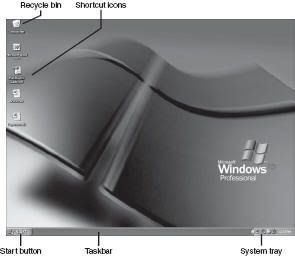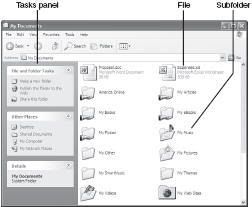Windows XP Basic
If you just purchased a new PC, your operating system is probably Windows Vista. But if you have an older PC, you’re probably running an older version of Windows—most likely, Windows XP. How does Windows XP differ from Windows Vista? And how does it work?
Windows Vista isn’t the first version of Windows. In fact, Windows has been around for more than 20 years, so Vista isn’t really reinventing any wheels. The first version of Windows, imaginatively dubbed Windows 1.0, was released way back in 1985. It was an improvement over the old MS-DOS operating system, which was completely character- and command-based.
Windows put a graphical user interface (GUI) on top of the DOS command-line engine and let users navigate through the onscreen windows with a mouse. That said, Windows 1.0 wasn’t all that great.
Yes, it was a tad easier on the eyes than the then-reigning DOS operating system, but it wasn’t much easier to use— and there weren’t many programs available for it. In fact, for several years, Microsoft Word and Excel were the only two applications that took full advantage of the Windows interface.
Fortunately, Windows got better. Microsoft upgraded Windows on a fairly consistent basis over the past two decades, bringing out a new version of Windows every few years or so. Sometimes the new version was a minor update; sometimes it was a complete overhaul.
For example, Windows 95 (released, unsurprisingly, in 1995) was a total rewrite of the previous 3.X version of Windows. Windows 98 (which followed in 1998) was a less-significant upgrade, and Windows 98 Second Edition (in 1999) was really no more than a minor bug fix.
Windows XP, released in 2001, was one of the most significant upgrades. It introduced a smooth new interface, full of rounded corners, and was significantly easier to use and more reliable than previous versions. There’s a reason why Microsoft waited five years to upgrade XP; this version of Windows worked pretty well.
Windows XP worked so well, in fact, that a significant number of computers are still running it. That’s why you’re reading this, after all— because your computer has Windows XP installed.
Windows XP desktop looks a lot like the Windows Vista desktop but without the see-through windows and the Sidebar. Everything else is where you’d expect it to be—the Start button, the taskbar, the system tray (what Vista calls the notification area), the shortcut icons, and the Recycle Bin.
Basic Operations
Basic operations in Windows XP are the same as in Windows Vista. You still have to learn how to point and click, double-click, right-click, drag and drop, and hover. Working with individual windows is also similar; you use the scrollbar to scroll through a long document and the maximize and minimize buttons to display or hide windows.
Within individual applications, Windows XP is a bit more reliant on menus than Windows Vista is. XP applications don’t have ribbons, and they don’t hide a lot of operations behind a single, somewhat vague Organize menu.
Instead, you have the normal application menu bar, with operations neatly organized on pull-down menus; many applications also have one or more toolbars. For example, in most Windows XP applications, all file-related operations—such as opening and saving a file—are found on the File menu.
Start Menu
Opening an application is still done via the Start menu, which appears when you click the Start button. (Note that in Windows XP the Start button actually has the word “start” on it.) Unlike Vista’s expanding and contracting All Programs menu, the All Programs menu in Windows XP cascades outward when you click a right-arrow next to an individual folder name.
Some users like it one way, some the other.
Switching Between Programs
Because Windows XP doesn’t have Vista’s fancy three-dimensional graphics, it also lacks the Windows Flip and Flip 3D methods of switching between programs. Instead, you can do any of the following:
- Click any visible part of the application’s window—including its title bar.
- Click the application’s button in the taskbar. (Unlike in Windows Vista, document thumbnails are not displayed above the taskbar buttons.)
- Hold down the Alt key and then press the Tab key repeatedly until the application window you want is selected. This cycles through all open windows; when you’re at the window you want, release the Alt key. (Unlike in Windows Vista, this does not display thumbnails of open windows.)
Shutting Down Windows XP
Shutting down Windows XP is actually a little less confusing than shutting down Windows Vista. If you recall, when you click Vista’s “power” button, you don’t actually turn off the power; instead, you put the computer into a special sleep mode. Not so in Windows XP—when you click the “power” button, you shut off the computer.
Simplicity itself. To shut down Windows and turn off your PC, follow these steps:
- Click the Start button to display the Start menu.
- Click the Turn Off Computer button.
- When the Turn Off Computer dialog box appears, click the Turn Off button.
- Manually turn off your monitor, printer, and other peripherals.
Working with the My Documents Folder
Where Windows Vista uses a similar series of Explorers to display files, folders, and configuration data, Windows XP simply displays the contents of folders within a window. It’s pretty much the same thing, except that each folder has its own distinct name.
By default, all your documents are stored within the My Documents folder. You open this folder by clicking the My Documents icon on the Start menu. As you can see in Figure 3, the My Documents folder not only contains files and subfolders but also displays a panel on the left-hand side, called the Tasks panel.
Vista doesn’t have a similar panel, and that’s too bad, because the Tasks panel is one of the most practical parts of Windows XP.
All the common tasks related to the open folder are displayed in this panel. All you have to do is select a folder or file and then click the appropriate task in the Tasks Panel. It makes copying, moving, and deleting files much easier.
Other Folders
The My Documents folder is just one of several similar folders within Windows XP.
You’ll also find the My Music folder, which contains all your digital music files; the My Pictures folder, which contains all your digital photographs; the My Network Places folder, which contains files and folders stored on other PCs in your computer network; and the My Computer folder, which lets you access all the disk drives on your main computer.
And, of course, Windows XP also has its own Control Panel, which you use to configure various aspects of your system.
Windows XP Applications
Windows XP contains many—but not all—of the same built-in applications as Windows Vista. You get Windows Media Player, Windows Movie Maker, and Internet Explorer, as well as Notepad, WordPad, and Paint. Instead of Windows Mail, there’s Outlook Express, which works pretty much the same way.
What you miss in XP are Vista’s new applications, including Windows Photo Gallery, Windows Calendar, and Windows DVD Maker. Know that depending on when Windows XP was installed on your PC, and how often it’s been updated, you may not have the latest version of some of these programs.
In particular, new versions of Internet Explorer (7) and Windows Media Player (11) are available for Windows XP. These new versions upgrade the programs so that they look and work pretty much like their Windows Vista cousins.
If you haven’t yet upgraded to these new versions, go to Microsoft’s website and do so now. There is no charge to download these upgraded versions.
Upgrading from Windows XP to Windows Vista
Now for the $64 question: Should you upgrade your computer from Windows XP to Windows Vista?
It all depends. Assuming that everything is working fine on your existing system, it might not be worth the bother. Yes, Vista comes with a few more built-in applications and is a tad bit more secure; that aside, the benefits of upgrading are few. Why mess with a system that’s working?
That said, some users always like to have the latest and the greatest, and Vista does offer a few more bells and whistles than you find with XP. If this sounds like you, the operative question is not should you upgrade to Vista, but can you upgrade?
You see, not all older PCs have the horsepower to run Vista, which is a more demanding operating system than the older Windows XP. To run Vista, your PC must meet or exceed the following system requirements:
- Microprocessor—For the Vista Home Basic edition, a 32-bit or 64-bit microprocessor running at a minimum of 800MHz. For all other editions, you’ll need at least a 1GHz microprocessor.
- Memory—To run the Vista Home Basic edition, you need at least 512MB RAM. For all other editions, go with a minimum of 1GB of memory.
- Hard disk—To run the Vista Home Basic edition, you need at least a 20GB hard drive with 15GB of free space. For all other editions, Microsoft recommends a minimum 40GB hard drive—much bigger is definitely better.
- Removable storage—The Vista Home Basic edition needs your PC to have a CD-ROM drive. (Read-only is fine.) All other editions need a CD/DVD drive for installation.
- Graphics—To display Vista’s basic interface, you’ll need a 3D video card that’s compatible with DirectX 9. To display the Aero interface, your PC’s video card must support DirectX 9 with Pixel Shader 2, have a minimum of 128MB graphics memory, and offer 32 bits per pixel, Windows Display Driver Model (WDDM) support.
If your PC doesn’t meet any of these requirements, you can upgrade those components necessary to run Vista—or just keep using Windows XP. As I said before, if it’s not broke, don’t fix it!


